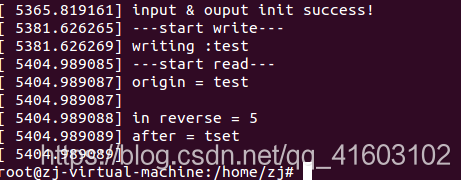目录
要求:实现一个proc文件,一个只读文件output,一个可写文件input;功能是:向input文件写入字符串后,可以从output文件中,读出input文件中反转后的字符串
1、编写proc文件
vim my_proc.c
#include <linux/module.h>
#include <linux/init.h>
#include <linux/kernel.h>
#include <linux/proc_fs.h>
#include <linux/uaccess.h>
#include <linux/slab.h>
#define BUFSIZE 1024
static struct proc_dir_entry *input, *output;
static char *buf;
static unsigned int len;
void reverse(void)
{
int i = 0;
int j = len - 2;
printk("in reverse = %u\n", len);
while(i < j)
{
char c;
c = buf[i];
buf[i++] = buf[j];
buf[j--] = c;
}
}
static ssize_t mywrite(struct file *file, const char __user *ubuf,size_t count, loff_t *ppos)
{
if(count <= 0)
return -EFAULT;
printk("---start write---\n");
len = count > BUFSIZE ? BUFSIZE : count;
// kfree memory by kmalloc before
if(buf != NULL)
kfree(buf);
buf = (char*)kmalloc(len+1, GFP_KERNEL);
if(buf == NULL)
{
printk("kmalloc failure\n");
return -EFAULT;
}
//memset(buf, 0, sizeof(buf));
memset(buf, 0, len+1);
if(copy_from_user(buf, ubuf, len))
return -EFAULT;
printk("writing :%s",buf);
return len;
}
static ssize_t myread(struct file *file, char __user *ubuf,size_t count, loff_t *ppos)
{
if(*ppos > 0)
return 0;
printk("---start read---\n");
printk("origin = %s\n", buf);
reverse();
printk("after = %s\n", buf);
if(copy_to_user(ubuf, buf, len))
return -EFAULT;
*ppos = *ppos + len;
return len;
}
static struct file_operations fo_input =
{
.owner = THIS_MODULE,
.write = mywrite,
};
static struct file_operations fo_output =
{
.owner = THIS_MODULE,
.read = myread,
};
static int proc_init(void)
{
input=proc_create("input",0660,NULL,&fo_input);
if(input == NULL)
return -ENOMEM;
output=proc_create("output",0660,NULL,&fo_output);
if(output == NULL)
return -ENOMEM;
printk("input & ouput init success!\n");
return 0;
}
static void proc_cleanup(void)
{
proc_remove(input);
proc_remove(output);
printk("input & output cleanup\n");
}
module_init(proc_init);
module_exit(proc_cleanup);
MODULE_LICENSE("GPL");
2、编写配套的Makefile
vim Makefile:
obj-m += my_proc.o
all:
make -C /lib/modules/$(shell uname -r)/build M=$(PWD) modules
clean:
make -C /lib/modules/$(shell uname -r)/build M=$(PWD) clean
3、测试
make 编译一下
如下
make -C /lib/modules/4.18.11/build M=/home/zj/neihe/proc_module_making/my_proc clean
make[1]: 正在进入目录 `/usr/src/linux-4.18.11'
CLEAN /home/zj/neihe/proc_module_making/my_proc/.tmp_versions
CLEAN /home/zj/neihe/proc_module_making/my_proc/Module.symvers
make[1]:正在离开目录 `/usr/src/linux-4.18.11'
然后sudo su 切换的root用户下
ls /proc/
发现多了2个文件:input ,output
ehco "test" >> /proc/input
cat /proc/input
打印:tset
ps:dmesg

内核探索暂时先到这里,先告一段落= =